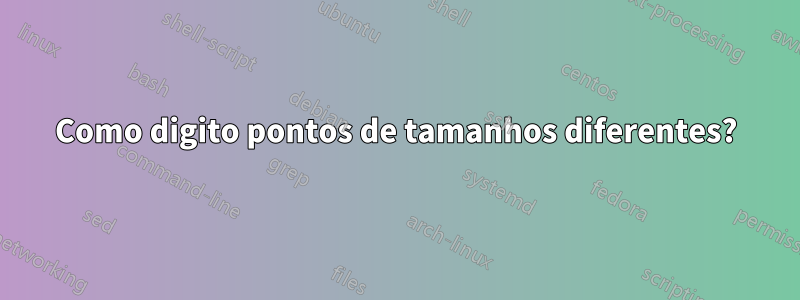
Responder1
No modo matemático padrão, você pode usar \circum pequeno ponto branco e \bulletum pequeno ponto preto. Usando o pacote wasysym, você pode usar comandos Circlee CIRCLEpara os grandes.
 Observe quedetexificaré uma ótima ferramenta para encontrar símbolos. Também existem muitas listas de símbolos LaTeX, comoEste.
Observe quedetexificaré uma ótima ferramenta para encontrar símbolos. Também existem muitas listas de símbolos LaTeX, comoEste.
Responder2
Aqui está meu exemplo:
\documentclass[12pt]{report}
\usepackage{tikz}
\begin{document}
$\circ $
$\bullet$
$\bigcirc$
Some Text \tikz\draw[black,fill=black] (0,0) circle (1ex); more text
\end{document}
Verifique também:Como desenhar um círculo de cor sólida?e para documentos ams-math:http://ftp.acc.umu.se/mirror/CTAN/info/short-math-guide/short-math-guide.pdf.
Responder3
Você pode usar alguns glifos mathabxsem carregar o pacote:
\documentclass{article}
\usepackage{geometry}
\DeclareFontFamily{U}{mathb}{\hyphenchar\font45}
\DeclareFontShape{U}{mathb}{m}{n}{ <-6> mathb5 <6-7> mathb6 <7-8>
mathb7 <8-9> mathb8 <9-10> mathb9 <10-12> mathb10 <12-> mathb12 }{}
\DeclareSymbolFont{mathb}{U}{mathb}{m}{n}
%
\DeclareFontFamily{U}{mathx}{\hyphenchar\font45}
\DeclareFontShape{U}{mathx}{m}{n}{ <-6> mathx5 <6-7> mathx6 <7-8>
mathx7 <8-9> mathx8 <9-10> mathx9 <10-12> mathx10 <12-> mathx12 }{}
\DeclareSymbolFont{mathx}{U}{mathx}{m}{n}
\DeclareMathSymbol{\newmoon} {\mathord}{mathb}{"4D}%swapped in the original file
\DeclareMathSymbol{\fullmoon} {\mathord}{mathb}{"4E}%swapped in the original file
\DeclareMathSymbol{\bigovoid} {\mathop}{mathx}{"EC}
\newcommand{\Circ}{$\vcenter{\hbox{$\newmoon\;$}}$}
\newcommand{\CIRC}{${\bigovoid}\;$}
\newcommand{\thickdot}{$\vcenter{\hbox{$\fullmoon\;$}}$}
\newcommand{\DOT}{$\vcenter{\hbox{\Large$\fullmoon\:$}}$}
\begin{document}
\fbox{\parbox{0.9\linewidth}{Here the vertices are indicated according to their heights, where \DOT denotes a vertex of height $3$, \thickdot denotes height $2$, \Circ denotes height $1$ and \CIRC denotes height $0$. }}
\end{document}





